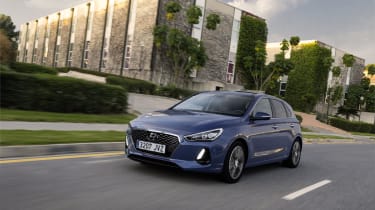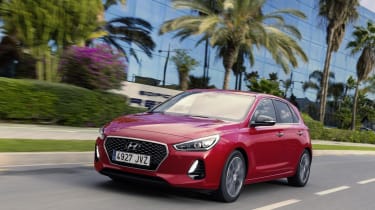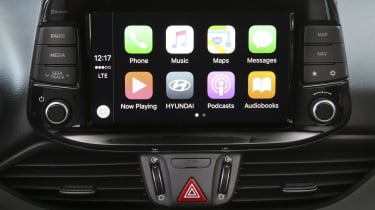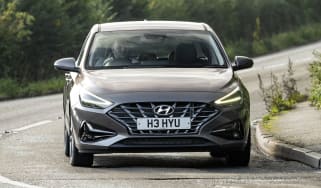New Hyundai i30 hatchback: prices, specs & release date
Pricing & specifications have been announced for Hyundai’s Ford Focus rival; new i30 prioritises safety, luxury & tech
The new Hyundai i30 goes on sale from 1 March and Hyundai is moving its Vauxhall Astra and Volkswagen Golf rival up a notch in terms of equipment and options.
The new i30 is offered in five trim levels. Entry-level S cars have alloy wheels, autonomous emergency braking, a lane-keeping assistance system and DAB radio, while top-spec Premium SE trim offers a taste of the finer things in life, with a heated steering wheel, leather seats and a panoramic sunroof.
In terms of engines, the new Hyundai i30 will be available with three petrol and three diesel options. The cheapest will be a 99bhp 1.4-litre petrol, but the turbocharged 1.0-litre three-cylinder and a new turbocharged 1.4-litre petrol are likely to be more attractive choices. Customers after a diesel i30 will find themselves with a 1.6-litre engine with a choice of three power outputs. Hyundai has also confirmed a powerful hot-hatchback version of the i30 will be offered, which is to be released under the company’s new ‘N’ performance sub-brand.
While prices have yet to be announced for the basic 1.4-litre petrol engine, the 1.0-litre turbocharged petrol is available from £16,995. That makes it marginally cheaper than the most affordable Renault Megane and SEAT Leon and – while it’s about £700 more than an entry-level Ford Focus – the arrival of the non-turbo 1.4-litre petrol engine should herald a more affordable i30, which is expected to undercut many key rivals. The new i30 range tops out with Premium SE trim at a whisker under £25,000.
Hyundai says there will be four distinct models of the new i30. These will comprise three and five-door hatchback versions, an estate Tourer and the performance-orientated Hyundai i30 N.
New 2017 Hyundai i30 design
You won’t find many bravely styled cars in such a competitive and conservative class and the new Hyundai i30 is no different. This latest effort is very much a case of evolution over revolution. Up front, the slinky LED headlights are wrapped around the front bumper and wing. Meanwhile, the daytime running lights are located in the front air-intakes and arranged as a vertical strip of LEDs.
First seen in the recently revised Hyundai i10, the new i30 will be the second recipient of the brand’s ‘cascading grille’. This feature is set to appear on all future new Hyundais and is trimmed in chrome on the i30. A further addition is the strong character line that runs from the front headlight cluster all the way around to the back of the car.
At the back, the rear lights are all-LED, too, while both the front and rear overhangs (the distance between the wheels and the front or back of the car) have been shortened compared to the previous model. This, according to Hyundai, helps give the new i30 a sportier, more ‘dynamic’ stance, as does the longer, heavily creased, bonnet and swept-back first roof-support pillar.
When it goes on sale, the new Hyundai i30 will be available in a choice of 12 paint colours, including three pearlescent finishes, seven metallic choices and two standard solid colours. Customers will also have the choice of 15,16 or 17-inch alloy wheels.
Interior
Inside, the new i30 is said to be “clean and intuitive” and there are some big changes from the previous iteration of the i30. The whole dashboard is brand-new, with an optional ‘floating’ eight-inch touchscreen sitting on top of it. There’s a new three-spoke multifunction steering wheel, which will be available with a heater function, as well as an all-new instrument binnacle. The controls for the air-conditioning and climate control are situated below the touchscreen in the centre console, while there are four trapezoidal air vents arranged across the dashboard.
You’ll be able to specify the new i30 with either cloth (black or grey) or leather seats. Go for the leather option and you have either a diamond pattern or a two-tone blue and black option. The driver’s seat is power-adjustable and can memorise two pre-set positions. You can also specify a panoramic sunroof and there's also a sliding front armrest with a storage space within it.
Engines & gearboxes
When it goes on sale, the new i30 will be available with three petrol engines and just one diesel. Two of the petrols are turbocharged – a 1.0-litre and an all-new 1.4-litre, producing 118 and 138bhp respectively. There’s also a 99bhp non-turbocharged 1.4-litre petrol. Fuel economy for the petrol engines officially ranges from around 50-62mpg (the non-turbo 1.4-litre is least efficient), while the diesels manage 68-78mpg.
The 1.0-litre turbo is only available with a six-speed manual gearbox, while the 1.4-litre turbo can be had with either this gearbox or a seven-speed dual-clutch automatic. The quickest model is the 138bhp 1.4-litre turbo with the six-speed manual, which will do the 0-62mph sprint in just 8.9 seconds, while the slowest model in the range – the non-turbo 1.4-litre – takes 12.6 seconds to do the same.
The i30’s CO2 emissions range from 89-130g/km, although due to April’s new road-tax rules, all models will cost £140 a year to tax after the first year. Company-car drivers’ Benefit-in-Kind (BiK) tax contributions will range from 18 to 21%.
Although there’s technically only one 1.6-litre diesel engine to choose from, it’s available in three different power outputs – 94, 109 or 131bhp. Depending on your power output and gearbox choice, the diesel i30 will take anywhere between 10.2 and 12.2 seconds to get from 0-62mph.
Suspension, brakes & steering
Hyundai says it’s put a lot of effort into improving the new i30's ride and handling characteristics. The steering on the new i30 is 10% more direct and responds 15 milliseconds faster than the outgoing model’s. Furthermore, all models get sophisticated rear suspension and the front brake discs have increased in size to 288mm. Meanwhile, the car is also 28kg lighter than the outgoing model, as well as being 22% stiffer. This will help both the driving experience and reduce running costs. The new i30 underwent testing at Germany’s famous Nürburgring track, and has been explicitly designed with European drivers in mind.
Practicality
Hyundai is also promising that the new i30 will be one of the most spacious and practical cars in its class. There are a number of interior storage spaces, while the boot can hold up to 395 litres, which is more than many key competitors, including the Ford Focus and Vauxhall Astra. Fold the rear seats down and the i30’s boot increases to 1,301 litres.
Trim levels & equipment
The new Hyundai i30 range starts with the S model, rising through SE, SE Nav, Premium and Premium SE. Entry-level S cars come with 15-inch alloy wheels, all-round electric windows, Bluetooth connectivity, a multifunction steering wheel, LED running lights and a host of safety kit – including autonomous emergency braking and lane-keeping assistance.
Moving up to SE trim costs roughly £1,700 and brings 16-inch alloys, a five-inch infotainment screen, front foglights, rear parking sensors and a reversing camera. SE Nav trim is up next, and you’ll need this trim if to upgrade to the 1.4-litre 138bhp turbocharged engine. For roughly £1,000 over SE trim, SE Nav gets you wireless phone charging, voice recognition and a larger eight-inch touchscreen, complete with sat nav, Apple CarPlay and Android Auto.
Things begin to get pretty pricey with the Premium model, which starts at just over £22,000. In fairness, this trim comes as standard with the new 1.4-litre turbocharged engine and also brings 17-inch alloys, dual-zone climate control, part-synthetic leather/part-cloth seats (which are heated in the front), tinted windows and an electronic parking brake. Premium cars also have LED headlights and a 4.2-inch information screen between the dashboard dials.
Finally, we come to Premium SE trim. For around £1,300 over and above the i30 Premium, this includes a tilt/slide panoramic sunroof, leather seats and a heated steering wheel.
Safety
Although the higher trim levels are more expensive, it’s fair to say Hyundai has been generous with safety equipment across the board with the new i30.
While some manufacturers make you pay extra for key protective technologies, all new i30s come with:
autonomous emergency braking – this brakes the car if it senses an obstacle you haven’t detected and attempted to avoidlane-keeping assistance – this takes corrective action if you leave your lane without indicatingdriver attention alert – this monitors if you’re getting tired at the wheel and reminds you to take a break if necessaryHigh beam assist – this automatically dips the i30’s headlights when it senses oncoming traffic, reverting to full beam when the road is clearAlso available is radar-controlled active cruise control, which can keep a set distance to the car in front at speeds above 6mph, while blind-spot detection can also be added.
Price & on-sale date
The new Hyundai i30 goes on sale on 1 March and is priced from £16,995 for the 1.0-litre turbocharged petrol engine and S trim, rising to £24,745 for the 108bhp diesel engine and Premium SE trim. We expect the i30 to get cheaper when prices are announced for the basic 1.4-litre non-turbo petrol engine and more expensive when the 134bhp diesel engine comes on stream.
Recommended
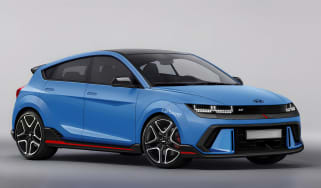
Smaller and cheaper electric Hyundai N car on the way
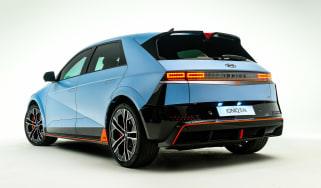
UK Hyundai Ioniq 5 N pricing announced, starting from £65k
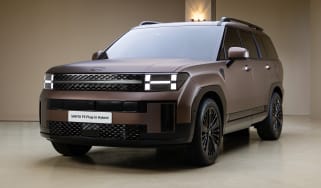
All-new Hyundai Santa Fe new images and technical details
Most Popular
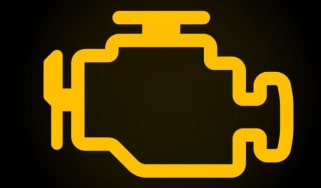
Engine management light: top 5 causes of amber engine warning light
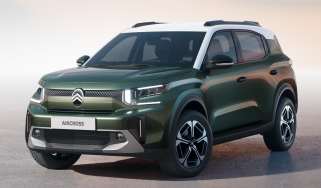
All-new Citroen C3 Aircross squeezes 7 seats into small SUV body

Best new car deals 2024: this week’s top car offers
Tips & advice



